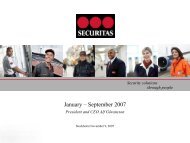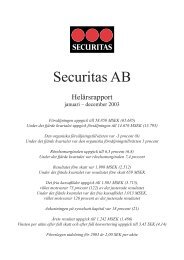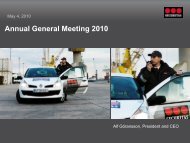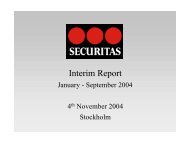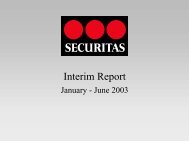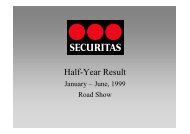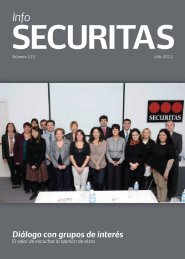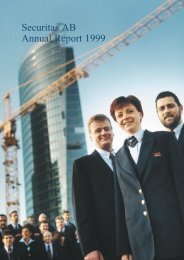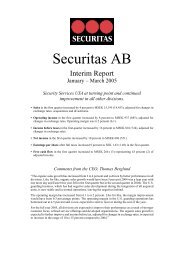Annual Report 2008 - Securitas
Annual Report 2008 - Securitas
Annual Report 2008 - Securitas
You also want an ePaper? Increase the reach of your titles
YUMPU automatically turns print PDFs into web optimized ePapers that Google loves.
70<br />
<strong>Annual</strong> report<br />
Notes and comments to the consolidated financial statements<br />
IAS 39 (amendment) Financial instruments:<br />
Recognition and measurement – Eligible hedged items<br />
The amendment, effective from July 1, 2009, is still subject to approval<br />
from EU. The amendment clarifies how the existing principles underlying<br />
hedge accounting should be applied in two particular situations. It clarifies<br />
when inflation can be identified as the hedged risk in a financial instrument<br />
and how to account for the use of options as hedging instruments. The<br />
Group will apply IAS 39 (amendment) from July 1, 2009.<br />
IAS 39 (amendment) Financial instruments:<br />
Recognition and measurement<br />
The amendment is effective from January 1, 2009.<br />
• This amendment clarifies that it is possible for there to be movements<br />
into and out of the fair value through profit or loss category, where a<br />
derivative commences or ceases to qualify as a hedging instrument in<br />
cash flow or net investment hedge.<br />
• The definition of financial asset or financial liability at fair value through<br />
profit or loss as it relates to items that are held for trading is also<br />
amended. This clarifies that a financial asset or liability that is part of a<br />
portfolio of financial instruments managed together with evidence of<br />
an actual recent pattern of short-term profit-taking is included in such<br />
a portfolio on initial recognition.<br />
• when re-measuring the carrying amount of a debt instrument on cessation<br />
of fair value hedge accounting, the amendment clarifies that a revised<br />
effective interest rate (calculated at the date fair value hedge accounting<br />
ceases) are used.<br />
• The amendment also includes some adjustments to IFrS 8 Operating<br />
segments.<br />
The Group will apply IAS 39 (amendment) from January 1, 2009. It is<br />
expected to have no impact on the Group’s financial statements.<br />
IFRIC 16 Hedges of a net investment in a foreign operation<br />
The interpretation, effective from October 1, <strong>2008</strong>, is still subject to approval<br />
from EU. It clarifies the accounting treatment in respect of net investment<br />
hedging. This includes the fact that net investment hedging relates to differences<br />
in functional currency not presentation currency, and hedging instruments<br />
may be held anywhere in the Group. The requirements of IAS 21 The<br />
effects of changes in foreign exchange rates do apply to the hedged item.<br />
The Group will apply IFrIc 16 from January 1, 2009. It is expected to have<br />
no material impact on the Group’s financial statements.<br />
IFRIC 18 Transfer of assets from customers<br />
The interpretation applies to transfer of tangible non-current assets or cash<br />
from customers received on or after July 1, 2009. The interpretation is still<br />
subject to approval from EU. It is expected to have no impact on the Group’s<br />
financial statements, since there are no such agreements with the Group’s<br />
customers.<br />
Other interpretations and amendments of existing standards<br />
There are a number of minor amendments to IFRS 7 Financial instruments:<br />
Disclosures, IAS 8 Accounting policies, changes in accounting estimates<br />
and errors, IAS 10 Events after the reporting period, IAS 18 revenue and<br />
IAS 34 Interim financial reporting, which are part of the IASB’s annual improvements<br />
project published in May <strong>2008</strong> (not addressed above). These<br />
amendments are unlikely to have an impact on the Group’s accounts and<br />
have therefore not been analysed in detail.<br />
Scope of the consolidated financial statements (IFRS 3)<br />
The consolidated financial statements relate to the Parent Company <strong>Securitas</strong><br />
AB and all subsidiaries. Subsidiaries are all companies where the Group has<br />
the right to govern the financial and operational policies in order to achieve<br />
economic benefits, in a way that normally follows a shareholding of more<br />
than one half of the voting rights.<br />
<strong>Securitas</strong> <strong>Annual</strong> report <strong>2008</strong><br />
Purchase method of accounting (IFRS 3)<br />
The purchase method of accounting is used to account for the acquisitions<br />
of subsidiaries and operations by the Group. The cost of an acquisition is<br />
measured at the fair value of the assets given, equity instruments issued<br />
and liabilities incurred or assumed at the date of exchange, plus costs directly<br />
attributable to the acquisition. Identifiable assets acquired and liabilities and<br />
contingent liabilities assumed in a business combination are measured<br />
initially at their fair values at the acquisition date, irrespective of the extent<br />
of any minority interest. The excess of the cost of acquisition over the fair<br />
value of the Group’s share of the identifiable net assets acquired is recorded<br />
as goodwill. If the cost of acquisition is less than the fair value of the net<br />
assets of the subsidiary acquired, the difference is recognized directly in<br />
the consolidated statement of income.<br />
The consolidated financial statements include companies acquired with<br />
effect from the date of the acquisition. Companies divested are excluded<br />
with effect from the divestment date.<br />
Pricing of deliveries among Group companies is based on normal business<br />
principles. Inter-company transactions, balances and unrealized gains<br />
between Group companies are eliminated. Unrealized losses are also eliminated<br />
unless the transaction provides evidence of an impairment of the<br />
asset transferred.<br />
Minority interests (IFRS 3)<br />
The Group has adopted the principle of treating transactions with minority<br />
interests as transactions with parties outside the Group. Disposals of minority<br />
interests result in gains and losses for the Group and are recognized via the<br />
statement of income. Acquisitions of minority interests give rise to goodwill<br />
that is determined as the difference between the purchase price paid and<br />
the acquired share of the book value of the subsidiaries’ net assets.<br />
Investments in associates (IAS 28)<br />
The equity method is used to account for shareholdings that are neither<br />
subsidiaries nor joint ventures, but where <strong>Securitas</strong> can exert a significant<br />
influence, generally accompanying a shareholding of between 20 percent<br />
and 50 percent of the voting rights. The cost of an acquisition is measured<br />
at the fair value of the assets given, equity instruments issued and liabilities<br />
incurred or assumed at the date of exchange, plus costs directly attributable<br />
to the acquisition. Identifiable assets acquired and liabilities and contingent<br />
liabilities assumed as a result of the acquisition are measured initially at their<br />
fair values at the acquisition date. The excess of the cost of acquisition over<br />
the fair value of the Group’s share of the identifiable net assets acquired is<br />
attributed to goodwill. If the cost of acquisition is less than the fair value of<br />
the net assets of the associated company acquired, the difference is recognized<br />
directly in the consolidated statement of income.<br />
The consolidated financial statements include associated companies<br />
with effect from the date of the acquisition. Associated companies divested<br />
are excluded with effect from the divestment date. Inter-company transactions,<br />
balances and unrealized gains between the Group and its associated<br />
companies are eliminated to the extent of the Group’s interest in the associate.<br />
Unrealized losses are also eliminated unless the transaction provides<br />
evidence of an impairment of the asset transferred.<br />
Share in income of associated companies are recognized in the consolidated<br />
statement of income depending on the purpose of the investment.<br />
Associated companies that have been acquired to contribute to the operations<br />
(operational) are included in operating income after amortization. Associated<br />
companies that have been acquired as part of the financing of the Group<br />
(financial investments) are included in income before taxes as a separate line<br />
within the finance net. In both cases the share in income of associated companies<br />
are net of tax. The classification of associated companies has been<br />
applied as follows in <strong>2008</strong>; the associated companies walsons Services Pvt<br />
Ltd, which was acquired in 2007, and Facility Network A/S, which was formed<br />
in 2007, have been classified as operational associates. The associated<br />
company <strong>Securitas</strong> Employee convertible 2002 Holding S.A., has up until<br />
its liquidation in 2007 been classified as a financial investment. In the consolidated<br />
balance sheet, investments in associated companies are stated<br />
at cost including the cost of the acquisition that is attributed to goodwill,<br />
adjusted for dividends and the share of income after the acquisition date.



